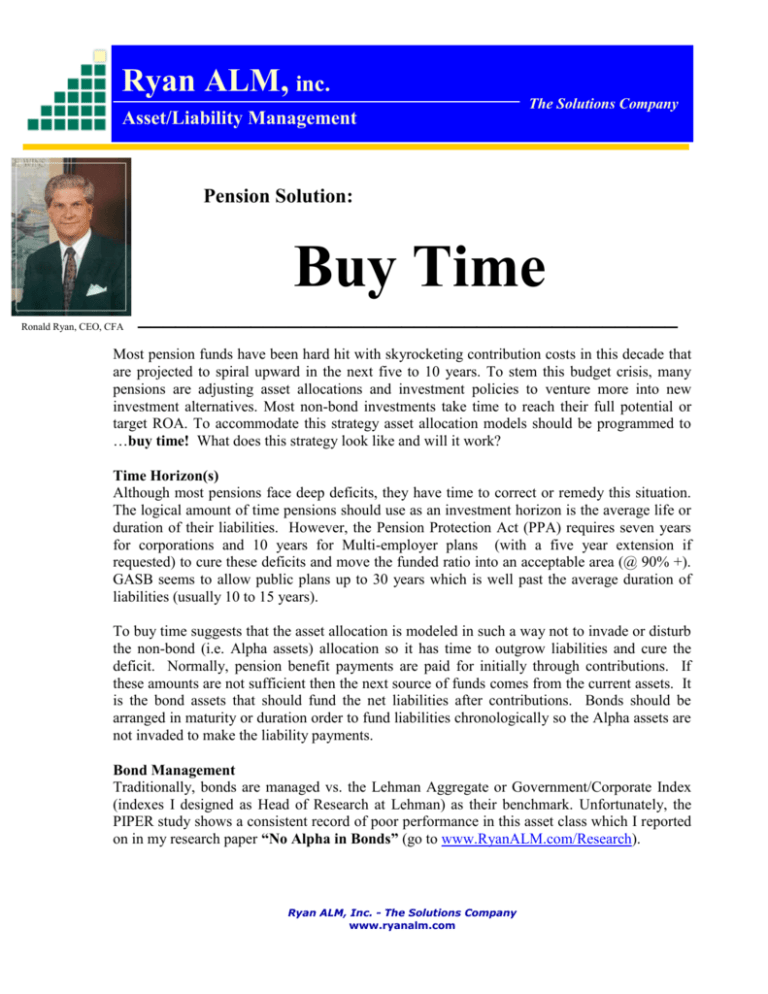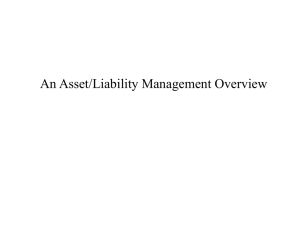
Ryan ALM, inc.
Asset/Liability Management
The Solutions Company
Pension Solution:
Buy Time
Ronald Ryan, CEO, CFA
___________________________________________
Most pension funds have been hard hit with skyrocketing contribution costs in this decade that
are projected to spiral upward in the next five to 10 years. To stem this budget crisis, many
pensions are adjusting asset allocations and investment policies to venture more into new
investment alternatives. Most non-bond investments take time to reach their full potential or
target ROA. To accommodate this strategy asset allocation models should be programmed to
…buy time! What does this strategy look like and will it work?
Time Horizon(s)
Although most pensions face deep deficits, they have time to correct or remedy this situation.
The logical amount of time pensions should use as an investment horizon is the average life or
duration of their liabilities. However, the Pension Protection Act (PPA) requires seven years
for corporations and 10 years for Multi-employer plans (with a five year extension if
requested) to cure these deficits and move the funded ratio into an acceptable area (@ 90% +).
GASB seems to allow public plans up to 30 years which is well past the average duration of
liabilities (usually 10 to 15 years).
To buy time suggests that the asset allocation is modeled in such a way not to invade or disturb
the non-bond (i.e. Alpha assets) allocation so it has time to outgrow liabilities and cure the
deficit. Normally, pension benefit payments are paid for initially through contributions. If
these amounts are not sufficient then the next source of funds comes from the current assets. It
is the bond assets that should fund the net liabilities after contributions. Bonds should be
arranged in maturity or duration order to fund liabilities chronologically so the Alpha assets are
not invaded to make the liability payments.
Bond Management
Traditionally, bonds are managed vs. the Lehman Aggregate or Government/Corporate Index
(indexes I designed as Head of Research at Lehman) as their benchmark. Unfortunately, the
PIPER study shows a consistent record of poor performance in this asset class which I reported
on in my research paper “No Alpha in Bonds” (go to www.RyanALM.com/Research).
Ryan ALM, Inc. - The Solutions Company
www.ryanalm.com
The Solutions Company
PIPER Study of Fixed Income Managers Taxable Separate Accounts
Annual Total returns
(10 years ending 12/31/08)
1st Quartile
Median
Lehman Aggregate
Lehman Govt/Corp
5.75%
5.22%
5.63%
5.64%
© 2009 Morningstar, Inc. All rights reserved. The information contained herein: (1) is proprietary to Morningstar and/or its content providers;
(2) may not be copied or distributed; and (3) is not warranted to be accurate, complete, or timely. Neither Morningstar nor its content providers
are responsible for any damages or losses arising from any use of this information. Past performance is no guarantee of future results.
The PIPER study shows the Median bond manager loses to the Lehman Aggregate bond index
for the last 10 years. After fees, the 1st quartile manager loses to the Lehman Aggregate
too! If 50% to 75% of the managers of an asset class lose to their benchmark index
consistently over time, this is strong evidence that you index this asset class. The question then
becomes what index to use. The obvious answer is a Custom Liability Index (CLI) that best
represents the true objective of the pension plan. Once installed, bonds can now be managed
as a Liability Index Fund or Liability Beta portfolio.
Custom Liability Index (CLI)
The CLI is based on the actuarial projections of the future annual benefit payment schedule.
Ryan ALM provides both a gross and net CLI (minus annual Contributions). Accordingly, the
CLI is pricing the actuarial projections at the market daily to create a series of reports
(Structure, Performance, Interest Rate Sensitivity). The CLI provides all the data to calculate
the economic Funded Ratio which supports the Asset Allocation decision. It also provides the
data for Performance Measurement (asset growth vs. liability growth). The CLI bridges the gap
between the liability side and the asset side. Most assets require an index benchmark or they
don’t understand the risk/reward behavior that the client is demanding. Actuarial reports are
very tedious and comprehensive documents that usually are produced annually months
delinquent. Such reports are not presented as an index with risk and reward calculations or
even the projected liability benefit schedule. It would be hard for any asset manager to manage
to an index if it came out annually, months delinquent with no tangible index portfolio and
frequent return history.
Liability Beta Portfolio
Defeasance, Dedication, Immunization, Prefundings, Lotteries, etc. have all demonstrated for
decades the best value of fixed income is its ability to match and fund liabilities. As the PIPER
study of fixed income asset management has proven, there is little value added in actively
managing bonds. If a pension has a deficit, bonds could not match and fund all the liabilities.
Moreover, there needs to be a heavy allocation to non-bonds (the Alpha assets) to outgrow
liabilities and cure the deficit. Bonds should be the core portfolio whose mission is to match
and fund liabilities chronologically. Suppose there is a 20% allocation to bonds. After
Contributions, this bond allocation might be able to match and fund the next eight years of
liabilities. The deficit to be cured and financed is now moved to longer liabilities which buys
time for the Alpha assets to outgrow liabilities. As the economic Funded Ratio (market value
Ryan ALM, Inc. - The Solutions Company
www.ryanalm.com
The Solutions Company
of assets/liabilities) improves, the Asset Allocation should respond and transfer more assets to
the bond side to match more liabilities chronologically thus buying more time for the Alpha
assets to perform. The more time the Liability Beta buys the better the odds of success. Most
important, the Liability Beta portfolio will reduce interest rate risk and the volatility of
Contributions since it matches liabilities and requires no contribution in the Beta space.
Asset Allocation
A Funded Ratio with a surplus should have a different asset allocation that if it had a major
deficit. The focus of asset allocation should be on the true economic Funded Ratio (market
value of assets/liabilities) not the ROA. As the Funded Ratio improves there should be a shift
in asset allocation towards more bonds (i.e. Liability Beta Portfolio) matched to liabilities. In
the late 1990s most pensions had surpluses. It would have been wise to shift the asset
allocation towards bonds matched to liabilities to secure this surplus. Because most plans
focused on the ROA they did not shift their asset allocation to bonds since bond yields were too
low to validate the ROA. This decision has damaged most pension plans solvency and their
plan sponsors budgets.
Asset Allocation should be viewed as a dynamic process since the Funded Ratio is indeed
volatile. This is described as Tactical Asset Allocation. It requires frequent monitoring. Every
time assets are reviewed, liabilities should also be reviewed. This would focus on the true
economic Funded Ratio. Based on this Funded Ratio, a decision on adjusting asset allocation
should also be reviewed. Too often asset allocation is a static, delinquent process reviewed
annually or even triennial. Since asset allocation accounts for over 90% of the total return of
any client, it is the most critical asset decision and needs to be monitored often with accuracy.
Without a Custom Liability Index, the market value of liabilities is not known and the true
economic Funded Ratio is not known. As a result, asset allocation can not function effectively.
This has been the sad story for most pensions in America for a long time.
Ryan ALM, Inc. - The Solutions Company
www.ryanalm.com








